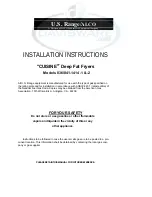
10
Common Drying Problems
Many drying problems involve poor cleaning results, poor soil and stain removal, residues of lint and scum, and fabric damage.
For satisfactory drying results, follow these suggestions provided by The Soap and Detergent Association.
PROBLEM
POSSIBLE CAUSES
SOLUTIONS
PREVENTIVE MEASURES
Greasy, oily
stains
Fabric softener sheet.
•
Rub fabric softener stains with bar
•
soap. Rinse and rewash.
Add a few bath towels to small loads for
•
proper tumbling.
Some “silk-like” fabrics should be air
•
dried.
Use proper drying temperature.
•
Place fabric softener sheet on top of load
•
before starting the dryer.
Lint
Overloading.
•
Overdrying causes static
•
electricity.
Lint screen not clean when
•
cycle began.
Lint is attached to “pills.”
•
Reduce load size and rewash using
•
liquid fabric softener in the fi nal
rinse.
Or, add a fabric softener sheet and
•
tumble without heat.
Use lint brush or roller to remove
•
lint.
Do not overload dryer.
•
Use fabric softener in washer or dryer to
•
reduce static electricity.
Remove items when they are slightly damp
•
to avoid overdrying.
Check that lint fi lter is clean and in place.
•
Pilling
(Fibers break off,
ball up and cling
to fabric.)
Overdrying.
•
Use a lint brush or shaver to re-
•
move pills.
Use fabric softener to lubricate fi bers.
•
When ironing, use spray starch or fabric
•
fi nish on collars and cuffs.
Turn items inside out to reduce abrasion.
•
Shrinking
Temperature too high.
•
Overdrying.
•
Irreversible condition.
•
Follow fabric care label directions.
•
If shrinking is a concern, check load often.
•
Remove items while slightly damp and
•
hang or lay fl at to complete drying.
Block knits into shape.
•
Wrinkling
Overloading.
•
Leaving items in dryer after
•
cycle ends.
Reduce load size and tumble at
•
medium or low heat for 5-10
minutes.
Remove items immediately. Hang
•
or fold.
Do not overload dryer.
•
Remove items as soon as cycle ends.
•






























